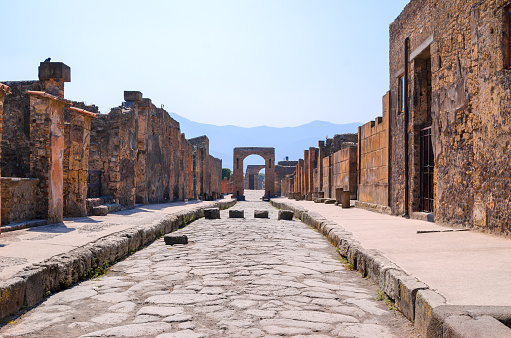
A Visit to Pompeii, Italy
 In 79 AD the 20,000 residents of Pompeii, Italy were enjoying one of the most prosperous times in Roman history. Pompeii was a very progressive city for its day with restaurants, theaters, a hotel, a temple, and at least four public baths. The Roman aqueducts brought running water into the town. On August 24, oddly enough, the day after the feast of the god of fire, Pompeii and a neighboring city, Herculaneum, were completely destroyed by the eruption of Mount Vesuvius, a volcano which towered over both these cities.
In 79 AD the 20,000 residents of Pompeii, Italy were enjoying one of the most prosperous times in Roman history. Pompeii was a very progressive city for its day with restaurants, theaters, a hotel, a temple, and at least four public baths. The Roman aqueducts brought running water into the town. On August 24, oddly enough, the day after the feast of the god of fire, Pompeii and a neighboring city, Herculaneum, were completely destroyed by the eruption of Mount Vesuvius, a volcano which towered over both these cities.
After the eruption of Mount Vesuvius, Pompeii lay buried in ashes and was virtually forgotten for almost 2000 years, until 1748. Excavations at Pompeii have been going on ever since. Beginning in the 1800's excavation methods were greatly improved, allowing many ancient buildings to be restored.
Today Pompeii, which is located near Naples, Italy, is possibly the most extensive well-preserved ruins of 1st century AD Rome. The ruins of Pompeii are visited by nearly two million tourists every year. The city walls have been restored and visitors can walk the original city streets to see the sites, with an ominous view of Mount Vesuvius looming in the background.
First, there are a number of public buildings that must be seen. The Amphitheater is the oldest and most preserved one in Italy. It was used for gladiator battles and had capacity to hold 20,000 people. Next to the Amphitheater is the Great Palaestra (Gymnasium), which was used for sporting events such as boxing and wrestling. The forum was the center of political, economic and religious life. The Basilica was the most important public building architecturally and was a place of trade and administration of justice. The Temple of Apollo has the oldest remains ever discovered.
Secondly, the houses of Pompeii give a significant glimpse into the lifestyle of some of the wealthy Roman citizens . One of the largest and most luxurious houses is the House of Faun. This house is as big as a city block and contains many beautiful mosaics. The House of Vettii was the home of two wealthy brothers who were possibly former slaves. It contains frescoes and graphic erotic images, reflecting the culture of that day. Other famous houses are the Villa of the Mysteries, which is outside the city gates, and the House of the Tragic Poet.
Finally, possibly even more captivating than the well-preserved buildings of Pompeii, are the plaster casts that were made from hollows of people who left their perfectly formed imprints in the ash. Thirteen of these casts, showing the exact places and poses in which the people died, can be seen in the Garden of the Fugitives.
Pompeii, Italy is without question one of the most interesting archeological spots in the world and gives an intriguing look into the art, culture and lifestyle of a fascinating people in the ancient world.
Pompeii is usually included or offered on tours that visit Naples, Sorrento and Capri.
